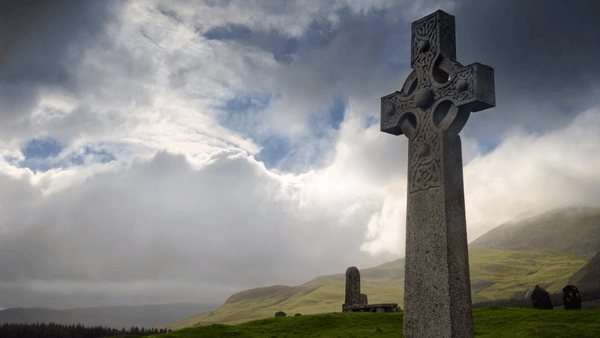
The Meaning Behind Celtic Symbols
Ireland has long been a country full of creativity and remarkable craftsmanship, much of which has evolved from the many different types of people Ireland has hosted over the millenniums, leaving their unique imprints on Irish history - but no one has influenced Ireland’s culture quite like the Irish Celts.
The impact of the Celts can still be seen in our national language, sports, music and art, continuing to keep their history alive to this day.
Their artistic capabilities run deeper than meets the eye, with the designs crafted by the Celts created with symbolism in mind.
One of the most prominent ways in which Celtic symbolism continues to maintain its presence is through Irish jewellery.
Celtic Irish Jewellery is as popular as ever, allowing people across the globe to continue to embrace Celtic heritage.
In this article, we are highlighting the most popular Celtic Irish symbols that have survived the test of time, and that hold beautiful, powerful meanings to those who possess them.
1. Trinity Knot
The Trinity Knot, or Triquetra, is most commonly known for its religious symbolism, created by the Celts to symbolise a relationship between three intertwining parts.
The overarching symbol most namely associated with the trinity knot is the Holy Trinity (The Father, The Son and The Holy Spirt), represented by the three corners.
The knot has also gained status and has become known as the ‘Irish Love Knot’ as it is believed to represent a promise to love, honour and protect, often said to be symbolic of marital vows.

2. Tree of Life
For the Celts, nature played a big role in their craftsmanship given their significant level of respect for the natural world.
In this context, many say that the Celts believed that trees were the predominant source of life and were powerful forces of nature.
It has since become a cherished Celtic symbol still to this day with the Tree of Life said to be representative of balance and harmony and is the connection between heaven, earth and the underworld.
Many have also interpreted this Celtic symbol to be representative of Irish family units, with each part of the tree relating to specific components of family life.
- The roots - the foundation and beginning of a family
- The outer ring - the circle of family
- The diamonds - each individual within the family

3. Celtic Cross
The Christian Cross is a symbol recognised from the Early Middle Ages in Ireland, Britain and France, many of which still stand today across Ireland, marking the most sacred grounds and paying a tribute to our Irish heritage.
This is a widely recognisable emblem of Celtic identity and is considered to be a symbol of navigation, with the four circles around the centre of the cross representing unification, totality, wholeness and inclusion.

4. St. Brigid's Cross
Saint Brigid, in Christianity, was one of Ireland’s patron saints, but Brigid has been traced back earlier to Celtic origins. For the Celts, Brigid was the Goddess of healers, poets, smiths, childbirth and inspiration and is commonly associated with the Spring.
St Brigid’s Cross is a powerful Irish religious symbol displayed in windows and doorways of homes as a safeguard from harm and acting as a token of protection, good health and protection from threats.

5. Celtic Spiral
The Celtic Spiral has been seen to date back as far as the creation of Newgrange, in Boyne Valley, Ireland. This Celtic Three Spiral, also known as Triskele, was previously found carved into the walls of this famous monument and has since become a symbol of Celtic culture.
The spiral is an ancient Celtic design which consists of a triple spiral structure, each believed to represent one of three worlds - the physical realm, the spirit world of the Celts’ ancestors, and the celestial world.
The Celtic Spiral, as a spiritual symbol, represents resilience and progress and aims to embody inner strength.

6. Shamrock
The Shamrock is a symbol most commonly associated with the Irish patron saint, St. Patrick.
This symbol is now known by many all over the world as a token of good luck.
It has been said that upon St. Patrick finding the Shamrock, he used it as a way to explain the Holy Trinity, appealing to the Celt's affinity for the number three.
Although associated with Christianity, the shamrock represented a turning point for Celtic Ireland, and the Celts, with their love for nature, would have embraced it and believed these sprigs to hold regenerative powers.

7. The Harp
As many will know, the Irish Harp is the national symbol of Ireland and holds within it a deep story of Ireland’s past.
The Harp was first declared as the national symbol of Ireland in 1541 after King Henry VIII assumed Kingship of Ireland and chose the crowned harp as the national symbol.
From this moment, the design of the Irish Harp underwent a variety of changes, often to facilitate the different political views of parties and groups across Ireland.
Now being recognised globally as the emblem of Ireland, many link the Harp with a sense of national identity and pride, with those who wear it showing that they still know how to listen between the lines of a soulful melody.

8. Claddagh
The Claddagh ring is a very traditional piece of Irish Jewellery that originated in the 17th century and although it does not come from Celtic times, we’re sure the Celts would have stood behind it.
The ring is comprised of three separate elements, each of which carries its own meaning.
- The hands - a symbol of friendship
- The heart - a symbol of love
- The crown - a symbol of loyalty
The Claddagh ring has since become a widely gifted piece of Irish jewellery as a symbol of friendship, as a parent-child bond link or even used as an engagement or wedding ring.

9. Ogham
The Gaelic Irish language, still spoken today, comes from the Celts. However, in the Early Medieval Ages, the Irish language was written with the Ogham alphabet, a beautiful symbol-based system that is also known as the ‘Celtic Tree Alphabet’.
As a symbol, Ogham’s meaning is highly personal to its holder, and Ogham jewellery is often customised to feature its holder’s name, or ‘love’, ‘friendship’ or ‘hope’.

10. The Celtic Warrior
The Celtic Warrior is a symbol holding great pride and respect for the hunters and warriors of their time.
With fighting being a major way of life for the Celts, they often entered battles with a variety of tattooed symbols on them, hoping to instil fear and intimidation among their enemies.
Today, Celtic Warrior symbols take on much the same meaning, and they are seen as ‘power centres’, epitomising willpower, purity, dedication and drive.

_________________________________
We hope that you enjoyed our blog on The Meaning Behind Celtic Symbols!
Browse our large collection of Celtic Jewellery here, featuring more than 1,000 beautiful jewellery items across women and men's jewellery, including bracelets, pendants, earrings, rings and more!

